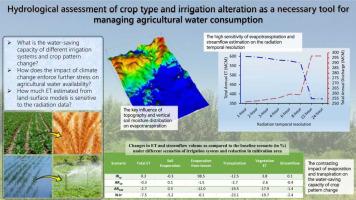Agricultural Water Management ( IF 5.9 ) Pub Date : 2022-06-03 , DOI: 10.1016/j.agwat.2022.107749 Javad Rahmani , Mohammad Danesh-Yazdi

|
The rapid shrinkage of Lake Urmia over the past two decades has raised serious environmental concerns. Several restoration plans have been proposed to reduce agricultural water consumption to supply a remarkable fraction of the lake’s environmental flow requirement. However, an accurate and realistic evaluation of the effectiveness of these plans in reducing agricultural water consumption across the basin is still poorly understood. This study assessed the water-saving potential of agricultural alteration in a snow-dominated catchment in the Lake Urmia Basin. In particular, we explored the impact of crop pattern alteration via reducing the cultivation area and employing different irrigation systems. We further studied the degree of extra stress on the agricultural water demand under the future trends of air temperature and precipitation due to climate change. To this end, we developed a three-dimensional physically-based hydrological model that simulated the main processes involved in the water and energy cycles. In this setting, a surface-groundwater model was coupled to a land-surface model that integratively computed the spatiotemporal variability of evapotranspiration, snowmelt, groundwater, and soil moisture in the root zone, among other processes. Pumping from wells and different irrigation systems were also included in the model. The results showed that a reduction in the cultivation area does not necessarily lead to a significant saving in the total water loss due to evapotranspiration, which strongly depends on the trade-off between the decrease in transpiration and the increase in soil evaporation. We further found that saving in agricultural water consumption is partly controlled by topography and the vertical distribution of soil moisture. Also, the drip irrigation system showed lower evapotranspiration rates than the spray irrigation system. Finally, the study of the future impacts of climate change revealed that the agriculture sector would be under more intensive stress, which poses a severe threat to the long-term restoration of Lake Urmia if effective agricultural management practices are not taken into consideration. The findings of this study highlight important issues for the Lake Urmia restoration plans on agricultural water management. Given the fragility of the lake ecosystem, this study suggests a reliable modeling framework for water and agricultural managers to identify the most appropriate regions in the basin that would yield the highest saving in agricultural water consumption by improving the current crop patterns and irrigation systems.
中文翻译:

量化农业变化和气候变化对乌尔米亚湖流域源头流域水循环动态的影响
过去二十年来,乌尔米亚湖的迅速萎缩引起了严重的环境问题。已经提出了几项恢复计划,以减少农业用水量,以满足湖泊环境流量需求的显着部分。然而,对这些计划在减少整个流域农业用水方面的有效性进行准确和现实的评估仍然知之甚少。本研究评估了乌尔米亚湖盆地以积雪为主的集水区农业改造的节水潜力。特别是,我们通过减少种植面积和采用不同的灌溉系统来探索作物模式改变的影响。我们进一步研究了气候变化导致的气温和降水未来趋势下农业用水需求的额外压力程度。为此,我们开发了一种基于三维物理的模拟水和能量循环中涉及的主要过程的水文模型。在这种情况下,地表-地下水模型与陆面模型相结合,综合计算了根区蒸发蒸腾、融雪、地下水和土壤水分的时空变化,以及其他过程。模型中还包括从井和不同灌溉系统中抽水。结果表明,种植面积的减少并不一定会显着减少因蒸散引起的总水分损失,这在很大程度上取决于蒸腾减少和土壤蒸发增加之间的权衡。我们进一步发现,农业用水量的节约部分受地形和土壤水分垂直分布的控制。此外,滴灌系统的蒸散率低于喷灌系统。最后,对气候变化未来影响的研究表明,农业部门将面临更大的压力,如果有效,这将对乌尔米亚湖的长期恢复构成严重威胁不考虑农业管理做法。这项研究的结果突出了乌尔米亚湖农业用水管理恢复计划的重要问题。鉴于湖泊生态系统的脆弱性,本研究为水和农业管理者提供了一个可靠的建模框架,以通过改善当前的作物模式和灌溉系统来确定流域中最合适的区域,从而最大程度地节省农业用水。











































 京公网安备 11010802027423号
京公网安备 11010802027423号